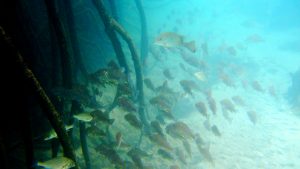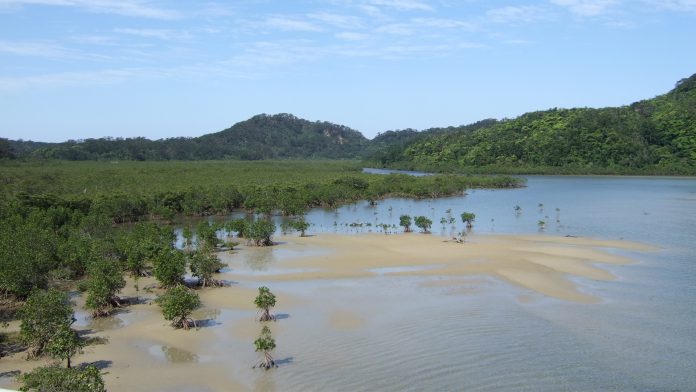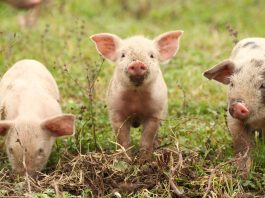Kusuto Nanjo from the National Fisheries University, Japan, explains why mangroves and their ecosystems must be conserved and managed.
Mangroves are salt-tolerant trees and shrubs that have flourished in the intertidal areas of sheltered shores, estuaries, and mudflats of tropical and subtropical regions. Mangroves are found in 123 countries worldwide, covering an estimated area of 15.2 million hectares (<1% of tropical forests). Extensive mangrove forests are found in Asia (39.0%), Africa (21.0%), North and Central America (15.0%), South America (12.6%), and Oceania (12.4%), more than 100 million people living within 10 km of large mangrove forests.1 Mangrove plants consist of about 70 species in 18 families, which include Rhizophoraceae and Avicenniaceae.
Mangroves are uniquely adapted to marine and estuarine conditions, with high salinity fluctuation and muddy anaerobic soils. They have the unique root systems, called ‘aerial roots’, providing gas transport in anaerobic sediments and supporting their trunks in soft muddy sediments. The shape of the aerial roots differs among species, such as ‘prop roots’ for Rhizophora spp. and ‘pneumatophores’ for Avicennia spp. These root systems also exclude salt from mangroves, while some species possess salt glands on their leaves.
Why are mangroves important?
Mangrove ecosystems provide a range of economic and environmental benefits to people who utilise them as ecosystem goods and services. Those can be assessed by ecological sustainability (e.g. nutrient and organic matter cycling), economic prosperity (the food and timber that people obtain), environmental security (protection from tsunami) and cultural values (acting as recreation fields).2 The estimated annual economic value of these ecosystems is US$200,000 – US$900,000 per hectare.
Mangroves are found at the interface between marine and terrestrial ecosystems and support unique fauna with high biodiversity by providing habitats, nurseries, shelter, and feeding areas for various animals such as reptiles, birds, mammals, fish, and shrimps. The latter two, fish and shrimps, include many commercially important species and thus the linkage between mangroves and nearshore and offshore fisheries has been focused on. More than 50% of global fish and shellfish harvests have been linked directly or indirectly to estuarine nurseries. In Southeast Asia, mangrove-associated species contribute 30% to fish and 100% to shrimp catches. Therefore, mangrove ecosystems significantly support the coastal economy by providing valuable fishery resources. Sustainable global marine fisheries are partly dependent upon the health of mangrove ecosystems.

Fish living in mangrove ecosystems
Fish are abundant in mangrove ecosystems and are a diverse marine component therein, with an estimated 600 species found in Indo West Pacific mangrove areas, which are represented by Mugilidae, Ambassidae, Lutjanidae, Gerridae, and Gobiidae. The fish found in mangrove estuaries can typically be consigned one of two categories:
- Marine migrant fish that spawn at sea and enter estuaries as juveniles (often in large numbers), such as the blacktail snapper Lutjanus fulvus and silver grunt Pomadasys argenteus, some of which utilise mangrove areas as nurseries.; and
- Estuarine resident fish that complete their life cycle within the estuarine environment, such as the halfbeak Zenarchopterus dunckeri.
Why are forests attractive for fish?
One of the major factors responsible for fish diversity is habitat complexity structured by mangrove vegetation, such as prop roots, pneumatophores, trunks, and fallen branches. It is generally believed that greater habitat complexity provides shelter from predation, increased microhabitat availability, and abundant food.3 The complex structure of mangrove roots enhances sedimentation rates and they also harbour epiphytic algae on their surface area, thereby enabling large numbers of small invertebrates (i.e. food resources for mangrove fish). In East Asia , zoobenthivorous fish, such as lutjanids – feeding mainly on crabs and shrimps – and herbivorous fish, such as pomacentrids, feeding on algae, inhabit mangrove root areas with more abundant food sources compared to unvegetated sand areas, suggesting greater food availability as a reason behind higher species richness in mangrove habitats.4
The habitat structure of mangroves may also provide potential refuge from predators for small fish by reducing prey visibility and limiting the movements of large predators. Several studies have demonstrated such sheltering effects by using artificial units that mimicked mangrove root structures. When artificial units with different levels of root densities were applied in natural mangrove forests, fish responded strongly to the root structure complexity of the units, with fish species richness and abundance being consistently higher in the units with roots than in those without. With increasing root density, fish abundance increased considerably, and predation mortality rates of small fish decreased.5 The sheltering effects provided by root structure against predators may also be a significant factor in explaining greater fish species richness/abundance in mangrove habitats.

The conservation of ecosystems
Mangroves have faced critical decline and degradation all over the world, at the rate of 0.66-1.0% per year, which is three-to-five times higher than the average rate of loss for land forests. As estimated, 20% (3.6 million hectares) of mangroves were lost between 1980 and 2005.1 Such loss was due to the conversion of these habitats to other uses, including infrastructure, aquaculture, and salt production.
The loss of mangroves leads to the loss of valuable ecosystem services, as well as to, of course, a significant decrease in the diversity of fauna and flora in mangrove ecosystems. Fish species richness and abundance have been found to be significantly decreased in cleared areas compared to mangrove areas.6 Such negative effects influence not only mangrove fish, but also offshore fish populations, such as coral reef fish, because some of them are highly dependent upon these habitats as nurseries. The destruction of mangroves thus results in a decrease of nearshore and offshore fish resources.
The reason for a decrease in fish may be a decline of prey abundance and shelter provided by mangroves, with many fish, including juveniles, unable to live in mangrove habitats. Therefore, mangrove forests should be conserved and managed in an effective manner. Marine protected areas have been established in several countries in order to conserve coastal ecosystems, although main targeted habitats in tropical regions are coral reefs, with only about 7% of global mangrove areas being covered.
When we look at fish species that need a connection to their habitat for completing their life cycles, conservation efforts should thus protect connected mangrove-seagrass-coral reef corridors. Furthermore, a recent study has shown that the genetic structure of the mangrove resident fish has differed among islands within an archipelago,7 indicating that conservation on a small spatial scale (i.e. at each island) also needs to avoid local extinction of resident fish and maintain not only species diversity but also the genetic diversity of these ecosystems.
References
- FAO 2007. ‘The world’s mangroves: 1980–2005’. FAO, Rome, Italy
- Sandilyan S. and Kathiresan K. 2012. ‘Mangrove conservation: a global perspective’. Biodiversity Conservation, 21, 3523–3542
- Nagelkerken I., Blaber S.J.M., and Bouillon S. et al. 2008.’ The habitat function of mangroves for terrestrial and marine fauna: a review’. Aquatic Botany, 89, 155–185
- Nanjo K., Kohno H., Nakamura Y., Horinouchi M., and Sano M. 2014. ‘Differences in fish assemblage structure between vegetated and unvegetated microhabitats in relation to food abundance patterns in a mangrove creek’. Fisheries Science, 80, 21–41
- Nanjo K., Kohno H., Nakamura Y., Horinouchi M., and Sano M. 2014. ‘Effects of mangrove structure on fish distribution patterns and predation risks’. Journal of Experimental Marine Biology and Ecology, 461, 216–225
- Shinnaka T., Sano M., Ikejima K., Tongnunui P., Horinouchi M. and Kurokura, H. 2007. ‘Effects of mangrove deforestation on fish assemblage at Pak Phanang Bay, southern Thailand’. Fisheries Science, 73, 862–870
- Hosoya S., Hirase S., Kikuchi K., Nanjo K., Nakamura Y., Kohno H., Sano M. 2019. ‘Random PCR-based genotyping by sequencing technology GRAS-Di (genotyping by random amplicon sequencing, direct) reveals genetic structure of mangrove fish’. Molecular Ecology Resources, 19, 1153–1163
Kusuto Nanjo
Assistant Professor
National Fisheries University
knanjo@fish-u.ac.jp
www.fish-u.ac.jp/e-index.html
Please note, this article will also appear in the third edition of our new quarterly publication.





